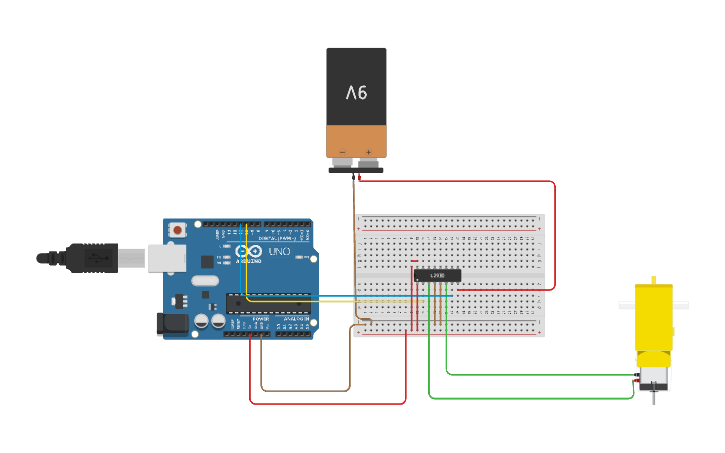3.jpeg)

3.jpeg&width=620&quality=80)
3.jpeg&width=175&quality=80)

3.jpeg&width=172&quality=80)
3.jpeg&width=300&quality=80)

3.jpeg&width=300&quality=80)
100 RPM BO Motor – Straight
The 100 RPM Single Shaft BO Motor, an ideal choice for DIY enthusiasts and robot builders seeking a versatile and affordable solution. This Plastic Gear Motor from the BO series is designed to deliver reliable torque and RPM at lower operating voltages, ensuring optimal performance for a range of applications.
₹ 61 ₹99
99



| Made In : | India |
Add FAQ
A BO Motor 100 RPM Single Shaft refers to a type of DC motor designed to rotate at a speed of 100 revolutions per minute (RPM), with a single shaft for mounting or connecting to mechanical components.
Key Features of a BO Motor 100 RPM Single Shaft:
-
100 RPM Speed:
- The 100 RPM indicates the speed at which the motor operates, meaning the motor completes 100 full rotations in one minute.
- This is a relatively low speed, typically suited for applications where slower, controlled movement is required, such as in robotics, conveyor belts, or turntables.
-
Single Shaft:
- The motor has a single shaft, which is the rotating part of the motor to which external loads can be attached. The shaft is typically made of metal or steel, and its dimensions depend on the motor design.
- The shaft can be used to drive various mechanical components such as gears, wheels, pulleys, etc.
-
DC Motor:
- The BO motor is likely a DC (Direct Current) motor, which means it operates on a DC power supply. This type of motor is widely used in applications where speed and torque need to be easily adjusted, as the motor's speed is directly proportional to the input voltage.
-
Applications:
- Small Mechanical Systems: The 100 RPM motor speed is often used in low-speed applications where precise movement is necessary.
- Robotics: For robotic joints, actuators, or movement systems requiring controlled, slow rotation.
- Conveyor Systems: For slow-moving conveyor belts that require consistent motion at low speeds.
- Model Applications: Often used in model trains, mechanical clocks, turntables, or other applications requiring slow but steady motion.
- Automated Equipment: Used in machines where gradual and controlled rotation is needed, such as in automated processes or testing systems.
-
Power Supply:
- The motor typically operates on a DC voltage, commonly in the range of 6V to 12V, though the specific voltage can vary depending on the motor’s design.
- The voltage rating should be checked to ensure it matches the power supply used in your application.
-
Torque:
- While the RPM value is important for speed, torque is equally critical for applications where the motor needs to drive heavy loads. The torque will depend on the motor's design and the load attached to the shaft.
- Low RPM motors tend to generate more torque compared to higher-speed motors.
-
Size and Mounting:
- The motor's size can vary but is typically small to medium in size, often with a standard 4mm to 10mm shaft diameter.
- It may be mounted using screws or other mounting accessories, depending on the intended use.
-
Efficiency and Current Consumption:
- The motor’s efficiency will depend on the load and speed, but typically low-speed motors like the 100 RPM version are relatively efficient for their intended tasks.
- The current consumption will depend on the voltage applied and the load driven by the motor.
Example Uses:
- Automated Door Systems: Slow, steady rotation required for door opening/closing.
- Toys: Mechanical toys that need a low-speed motor to rotate parts or wheels.
- Small Vehicles: For model cars or miniature vehicles where a low RPM is needed for controlled speed.
- DIY Projects: In hobby projects like solar-powered devices or small robots that require low-speed rotational movement.
Motor Characteristics:
- Voltage Rating: Ensure you provide the motor with the correct voltage as specified in the datasheet (typically 6V, 12V, etc.).
- Current Rating: Be aware of the current consumption of the motor to match the power supply and avoid overloading.
- Mounting: The motor will typically have a standard shaft size that matches gears, wheels, or pulleys for various mechanical attachments.
Conclusion:
A BO Motor 100 RPM Single Shaft is a specialized low-speed motor ideal for applications requiring controlled, slow rotations. It's typically used in hobby projects, robotics, small machinery, or any application where a consistent and slow rotational speed is required. Ensure that you match the motor's power supply and load requirements to get the best performance from the motor.

0 Reviews For this Product





3.jpeg&width=225&quality=80)







